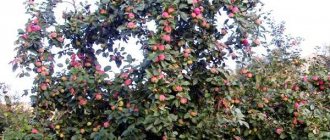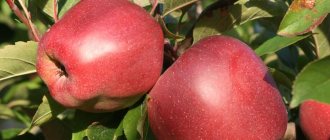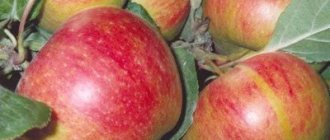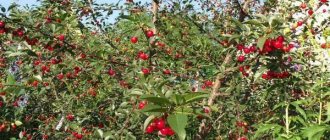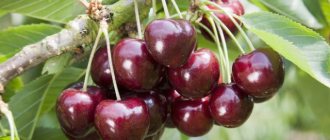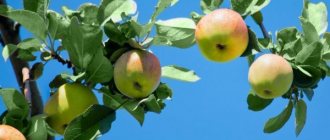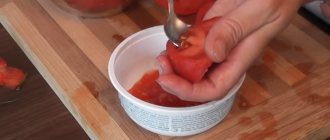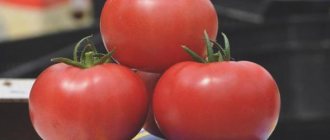These apple trees are popular in temperate latitudes, in the middle zone of our country. The Moscow apple tree variety is winter-hardy later, does not cause problems in care, and has a long shelf life. The tree is resistant to the main disease of all apple trees - scab.
Moskovskoe later is an apple tree, the description of which became available to gardeners in 1961. The variety belongs to the selection of Moscow State University. M. V. Lomonosov. It was obtained by crossing two well-known varieties - Northern Signal and Brown New. Its author was S.I. Isaev. In 2001 it was zoned.
Moscow apple tree later: description of the variety
This is a representative of late (winter) ripening varieties. The first fruits can be collected at the very end of September or early October. They have surprisingly good keeping quality. With proper care, they remain in excellent condition until the next year's harvest. It is recommended to store them in basements and cellars at temperatures from +2 to +6 °C. Sudden temperature changes must be avoided.
The late Moscow apple tree is pollinated. The following varieties act as pollinators:
- Knight.
- Synap.
- Orlovsky.
- Bogatyr.
- Moscow winter.
Today, the late Moscow apple tree is widespread in the Central region and neighboring regions. This variety is successfully grown in Belarus and Ukraine.
Apple tree Moscow Later
A good orchard has been grown at the dacha and the Moscow Later apple tree is growing. The tree is tall, the crown is oval, the foliage is not dense, so the apples get enough sun. They themselves are also very large! I like their shape: cups, conical. The weight is also good, on average 200 grams, plus or minus 40 grams. The color of the fruit is green, but when it sits, it turns golden. Caring for an apple tree is difficult: the crown is large, our height is somewhere around 5 meters. You still need to trim off the dried and unnecessary branches, but this is problematic. The harvest is good because I water the tree and sprinkle fertilizer around the tree trunk. We get 10-12 buckets from an apple tree. We harvest from late September to early October. Apples are sweet and sour and last a very long time, until summer. The winter hardiness of the apple tree is good, it is not afraid of frost, but it must be protected from rodents with a net. This apple tree, and it is 10 years old, does not suffer from any diseases.
The most popular varieties of apples among gardeners are winter ones. The Moscow apple harvest later occurs in late autumn. They all have a fairly long shelf life. But usually such apples are not eaten right away. Although they taste quite acceptable even in September. They can be used as early as December. They need this time to gain taste and juiciness. Apple trees of this variety begin to bear fruit only in the 5th year of life, this is quite a long period. The apples are ruddy, green-pink with dense and juicy pulp. I like to use this variety for juicing. It turns out quite thick with a characteristic aroma. Apple trees of this variety are resistant to diseases, but do not forget about careful care of pests and diseases. After the leaves fall, I treat the trunks with urea. In addition, it is very sensitive to watering. Additionally, it is necessary to water during dry times. The variety is quite frost-resistant. It doesn’t even need to be additionally insulated for the winter. The trees tolerate frosts well down to minus 25 degrees. Apples weighing 100-200 grams. Given the abundant fertility, the harvest is consistently large.
To grow Moscow winter, you need, first of all, to be patient and spend a lot of effort in caring for the seedling in the first years. The apple tree grows very quickly, the annual growth of the trunk and branches is more than 10 cm, so regular pruning and crown formation are required. Due to intensive development, Moskovskoye requires a large amount of fertilizing and constant watering. The first harvest can only be expected 6-7 years after planting; if the apple tree blooms earlier, the flowers will have to be mercilessly plucked off, otherwise this will stop the development of the tree. If it was properly cared for, then after the 7th year the apple tree will begin to actively bear fruit and the amount of harvest will grow; in the 10th year you can harvest about 150 kg of large and strong apples. The harvest ripens by the end of September, apples are stored for a long time, while retaining their nutritional qualities until spring. The Moscow winter fruits contain a lot of pectin, vitamin C and even vitamins A, group B, E and PP. An adult tree is unpretentious in care, tolerates cold well even at -35C, only spring frosts have a bad effect on it, and in such a year it may not produce the usual harvest. The tree is resistant to common powdery mildew and scab, but bacterial burn and cytosporosis can affect it.
Tree
Moscow later - the apple tree, the photo of which we posted in this article, is a vigorous tree. At a young age, the crown is broadly pyramidal in shape, but with age it changes to broadly oval. Leaves on the branches are located quite sparsely. The bark of the trunk and main branches is greenish-gray. The skeletal branches are characteristically located in an oblique-vertical position.
Description of fruits
The fruits of the Moscow late apple tree, descriptions, photos of which can be seen in all gardening reference books, are medium or large in size. One apple weighs on average one hundred and 65 grams, but often the weight of the fruit reaches 210-235 grams. They have a leveled, regular round-conical shape and a smooth surface.
By the time they are ripe, the fruits are colored greenish-yellow, the outer color is rather weak - a delicate pink blush is located on the sunny side. At consumer ripeness, apples are covered with golden-yellow skin. Subcutaneous dots are barely distinguishable: they are small, colored greenish.
The stalks are medium in thickness, erect, short. The funnel is medium in width and depth. The saucer is of medium depth and quite wide. The subcalyx tube is short in length and broadly funnel-shaped in shape with slightly open seed chambers. The seeds are medium in size, round in shape, and brown in color.
Winter apple tree Moscow later
Main characteristics
Fruit ripening period:
detailed information
Origin
The late-winter Moscow apple variety was bred as a result of crossing the Cinnamon new varieties (Cinnamon striped x Welsey) with the Northern synapse (Kandil-Chinese - open pollination) 1961. Originators of the variety: Moscow State University. M. V. Lomonosova S. Author – I. Isaev.
Features of growth
The winter apple tree Moscow later is a vigorous, tall tree (reaches 6 meters in height), at a young age the crown is wide-pyramidal, over the years it turns into a wide-oval one. The apple tree bears fruit within a year, and continues to bear fruit regularly for a long time. Advantages of the variety: long shelf life; high consumer characteristics; frost-resistant; has immunity to scab. The variety has no serious disadvantages. True, the density of the crown is considered a small disadvantage if the pruning procedure is not carried out.
Places of distribution
Resistance to low temperatures exceeds average values, therefore it is considered ideal for Central Russia.
It is resistant to low temperatures above average, so the variety can be considered suitable for the central zone of our country.
Diseases/pests
Scab resistant.
Fruit
The fruits weigh on average 165 - 235 g, round-conical shape. The skin of apples is smooth, the main color when ripe is greenish-yellow, the outer color is in the form of a pink blush on the sunny side; The peduncle is medium thick, short, set straight. The cup is half-open, the saucer and funnel are of medium depth, there is no rustiness. The subcalyx tube is wide-funnel-shaped. The seed chambers are semi-open, the seeds are small and brown. The pulp of the Moscow late variety is white, fine-grained, very juicy, dense, and sweet and sour in taste. The ripeness of the fruits occurs at the end of September. Apples of the Moscow variety are later distinguished by their amazing keeping quality, right up to the next harvest. The beginning of the period of consumer maturity coincides with the removable period and lasts until May. The tree begins to bear fruit at the age of 10.
Leaves
The leaves are green, very large, ovoid. The petiole is abundantly pubescent, short, and colored along its entire length.
The bark on the trunk and main branches is greenish-gray. The shoots are brownish-brown, round in cross-section, straight, abundantly pubescent.
Chemical composition
The fruits of the Moscow late apple tree contain:
- sugar - 9.29%;
- titratable acids - 0.94%, but limits from 0.70 to 0.97% are allowed;
- tannins - 55 mg/100 g (permissible limits from 41 to 67 mg/100 g);
- ascorbic acid - 8.8 mg per 100 g;
- P-active substances - 0.15 mg per 100 g;
- pectin substances - 8.7% by dry weight.
The fruits of the late Moscow apple tree are universal. They are used both fresh and after culinary processing.
Description, photo
The hybrid was bred in the early 60s by breeders of the Moscow Society of Natural Scientists at Moscow State University named after M.V. Lomonosov by crossing the new Cinnamon and the Northern Sinap variety. The author was the famous breeder S.I. Isaev.
Official zoning took place much later – 40 years later.
Refers to late winter ripening varietal crops . The tree is tall. While the tree is young, the crown is characterized by a wide pyramidal appearance, which over the years turns into a rather wide oval.
The color of the trunk and main branches is green-gray. The main arrangement of branches is vertically inclined. The sheet covering is characterized by average performance.
The shoots are smooth, round in shape, have strong pubescence and a brownish-brown tint. The sections of the stem between two adjacent shoot nodes are short. The leaves are large, have jagged edges and short, fleecy petioles.
The fruits are considered quite large. The usual weight is about 160 g, but specimens grow up to 230 g. The apples are smooth, round, and cone-shaped. The skin is smooth, without pearls and ribs.
Important! Removable maturity coincides with consumer maturity.
The main color of apples: yellow-green. A slight blush appears on . After long-term storage, the color changes to golden and resembles a waxy fruit.
Fruits of the Moscow apple tree later.
Productivity
It is interesting that it was initially assumed that the Moscow apple tree later (you can see the photo below) begins to bear fruit in the tenth year - during this period it produces its first fruits. However, it later turned out that the seedlings bear fruit much faster - already in the sixth or seventh year. This usually happens with seedlings obtained through propagation.
The average yield is 160 kilograms per tree or 110 centners per hectare.
Planting seedlings
When choosing a seedling, you need to pay special attention to the condition of the young tree’s trunk. If it is severely curved, then it is likely that its root system is damaged, so you should not purchase such a seedling. There is a high probability that it will not be accepted or will grow deformed, which will undoubtedly affect the quality and quantity of the harvest.
After purchasing a seedling, it must be shortened to 80 centimeters if it exceeds these parameters. If the roots are shorter than 40 centimeters, the tree is pruned even further, since small roots will not sufficiently provide the crown with moisture and nutrients.
Before planting, straighten the roots of the seedling well, remove all damaged parts, and be sure to disinfect the cut area with garden varnish. If the roots of the tree are too dry, soak the seedling in water overnight, in this case the plant will take root faster and better.
The late Moscow apple tree needs a good drainage layer. Dig a planting hole measuring 70x70x70 cm and place drainage at the bottom. Expanded clay, broken brick, and pebbles are usually used as it. The soil for planting must be divided into two layers: upper and lower. At the bottom, on top of the drainage, place a mixture of the top layer and nutritional supplements. They can serve as compost and humus. It is not recommended to add manure to a garden hole.
A top layer of soil without impurities is added on top. This is necessary so that the roots of the young tree do not come into contact with fertilizers. This may cause root burn. The mixture of soil and fertilizer should form a small mound on which the seedling is placed. Near it, it is necessary to drive a peg to which the tree is tied so that the trunk does not deform under the weight of the crown. After planting, the tree is watered with two or three buckets of water.
Features of planting and care
Planting and preparation for it are two events, the quality of which determines the speed of establishment of the plant on the site and the yield in the future. Caring for an apple tree includes a set of measures aimed at strengthening the plant’s immunity, protecting against pests, and increasing fruitfulness. Each agrotechnical action must be carried out in a timely manner in accordance with the stage of plant vegetation.
Video: Instructions for planting an apple tree
Planting dates and scheme
The crop can be planted in autumn and spring. In the first case, you need to have time to plant the seedling 2 weeks before the cold weather. It is permissible to carry out the manipulation after snow has fallen, the main thing is that the soil is not frozen. Naturally, autumn planting is advisable only in the south, where the soil does not freeze in winter. In the central zone, planting should be carried out only in the spring, after the snow cover has melted and before the buds swell - in April - May.
The planting scheme for tall apple trees of the Moscow variety is later than 5x5 m. If this parameter is reduced, the trees will suffer from a lack of nutrition and oppress each other.
Did you know? In Ancient Persia it was believed that if you make a wish and eat 40 apples, it will definitely come true.
Landing technology
In order for the tree to quickly take root on the site, soil preparation begins six months before planting. At this stage, deep cultivation (30 cm) is carried out, the soil is disinfected with a solution of copper sulfate, and a week later, under cultivation, the following is added to a depth of 20 cm for each square meter:
- 10 kg of peat and sand - if the soils are heavy (you can omit adding them to “light” soils);
- 400 g superphosphate;
- 20 kg of fresh manure.
A month before planting, another cultivation is carried out. For each square meter, add 20 kg of compost and 800 g of wood ash. A week before planting, they dig a hole. The depth of the pit is 60 cm, width 80 cm. The top layer of soil, 30 cm, is folded separately.
Did you know? Peat is not only an element that facilitates the structure of the soil. The fibers contained in its composition are used in the manufacture of carpets, and the absorbent properties of the natural material have found application in the pharmaceutical industry.
It will then need to be mixed with:
- 10 kg of sand and peat;
- 20 kg of compost;
- 6 tbsp. l. nitrophoska.
The resulting soil mixture must be filled 1/3 of the hole, then drive a stake into the center and pour in 30 liters of water.
The planting technique is as follows:
- The roots of the seedling are cut back to healthy tissue - until the white color is visible on the cut.
- Immerse the root part in a bath with a growth accelerator for 2 hours. You can take “Epin” liquid or “Fitosporin” powder. For 5 liters of water, the first drug will require 7.5 ml (can be measured using a syringe), or 10 g of the second drug (a whole bag).
- A mound is made in the center of the hole on which the roots are placed. Then leveling is carried out with orientation towards the place of budding - when the hole is filled, it should rise above the soil by 5 cm.
- After leveling, fill the hole with soil, then compact the tree trunk circle and fill in 20 liters of water.
- Once the water is absorbed, the soil will settle slightly. The missing volume will need to be filled with fertile composition and mulched with compost or sawdust (5 cm layer).
- The height of the trunk is regulated - the plant is shortened to 80 cm. This will help reduce the growth force of the tree and maintain its optimal height in the future.
Fig. 1 - process of planting a seedling, Fig. 2 - correctly planted seedling
Feeding and watering frequency
Fertilizers begin to be applied 4 years after planting. At this time, the plant will have enough nutrients that were added at the preparation stage before planting. In the spring, before the buds swell, add 6 tbsp to 30 liters of water. l. nitrophoska or a similar amount of urea. The next year, instead of minerals, add liquid mullein diluted with water (1:1).
After flowering, potassium fertilizers are applied, for example, an infusion of nettle with ash. To make it, take (per 20 liters of water) 10 kg of nettle and 1 kg of ash. Add 1 tbsp to the mixture. l. sugar and leave in the sun in a closed container. Be sure to stir the mixture every 2 days. When it has fermented, strain it, dilute it with water 1:1 and pour it into the tree trunk. Fermented greens are used as mulch. The last time fertilizing is done is after harvesting. For digging, 90 g of superphosphate and 20 g of potassium sulfate are added per square meter of the tree trunk circle.
Find out more about the features of seasonal feeding of apple trees.
To achieve abundant fruiting, it is necessary to provide the tree with a sufficient amount of moisture. Perhaps watering is the most difficult task, because here it is important not to cross the fine line between a lack of moisture and its excess.
Proper watering involves moistening the soil to a depth of 45 cm. In the first year after planting, the tree is irrigated once a week. Water is poured under the root. 1 plant requires 20–30 liters of water, depending on the climate. In the second and third years, they switch to the “Once a month” watering regime. For 4-5 year old specimens, add water once every 2 months.
Moscow later needs regular watering
More mature plants are watered schematically, and in temperate latitudes, where there is enough precipitation, the soil is not moistened at all. For the first time, intensive watering is carried out immediately after flowering. The tree is irrigated a second time when the fruits begin to swell. The third is in October, before wintering. The abundance of the third watering will be determined by weather conditions. The drier the climate, the more water will be needed. On average, an adult tree uses from 40 liters to 70 liters of water per watering.
We recommend reading about the features of autumn apple tree care.
Pruning and crown formation
Formative pruning is carried out for 4-5 years, before the plant enters the fruiting phase. In the first year after planting, 3-5 shoots of the lower tier are left, shortening them to 30 cm, the rest are cut off.
The main skeletal branches are left only by those that grow higher than 50 cm from the ground level. There should be a distance of 15 cm between the shoots. It is necessary to ensure that the central conductor is 15–20 cm longer than the others. This criterion must be adhered to throughout the life of the plant.
To obtain a decent harvest and high consumer quality of fruit, the plant needs annual pruning and shaping, as well as systematic nutrition.
The next year, a second tier is formed, leaving 2-3 sprouts on the shoots of the first tier. All branches are cut so that they are 15 cm shorter than the main ones, and the main ones are shortened relative to the main conductor by 15 cm. In the third year, in a similar way, the third tier is formed, and then, if desired, the fourth.
Formation is carried out in early spring, before sap flow begins. In the future, once a year, damaged branches and shoots that thicken the crown are cut off and the main ones are shortened.
Important! All
conductors that can compete with the main ones must be immediately
cut to
zero
. Otherwise, the density of the crown will increase and the tree will bear fruit worse.
Disease and pest control
To protect against diseases and pests in the spring, the lower part of the trunk is whitened with slaked lime. The tree is sprayed with Bordeaux mixture:
- before buds open;
- before flowering;
- after harvesting.
After a year, preventive spraying using copper-containing preparations is replaced by treatment using biological products - “Fitoverm”, “Fitosporin” or “Emochka-Fertility” (according to the above scheme), following the manufacturer’s instructions.
With increased soil and air humidity, even if all agricultural practices are followed, there is a high risk of infection with fungal diseases.
In Moscow late, the following lesions are most often observed:
- powdery mildew;
- moniliosis;
- brown spotting.
An excellent remedy that is highly effective against most strains of fungi is Mancozeb. It is used according to the instructions.
Among the pests that are dangerous for the apple tree of the variety in question are:
- aphid - eliminated by dusting branches and soil with tobacco dust;
- leaf roller - it can be dealt with by treating the ground part of the plant and the soil around the trunk with ash;
- false scale insect and scale insect — the drug “Fitoverm” will help get rid of them.
Preparing for winter
In the fall, it is necessary to prepare the tree for the winter cold. To do this, in mid-late September, intensive watering of the tree trunk circle is carried out, and the condition of the bark and branches is assessed. Damaged parts must be removed, treated with activated carbon and covered with garden pitch. Then, preventive spraying is carried out with copper-containing or biological products, according to the seasonal work schedule. The soil is mulched with dry manure. The height of the mulch layer should not be less than 10 cm.
Find out more about the features of whitewashing an apple tree in autumn and spring.
The trunk is whitened to a height of 1 m from the soil level. Apple trees up to 6 years old, growing in the central zone and to the north, must have the trunk wrapped in burlap or agrofibre.
Care
Watering is one of the most important factors in caring for Moscow late. Trees need abundant systematic irrigation. This is especially important during the flowering period and in dry years. Plant turf or a carpet of clover next to the tree - this will help maintain the necessary moisture concentration.
For Moscow Late, pruning is very important. It stimulates the realization of the vital forces of the tree. For this reason, the next year after planting, they begin to artificially form the crown. Sprouts and young shoots that grow inside the crown or branches that develop at an acute angle are shortened.
If the seedling blooms in the first years of its life, before reaching its sixth birthday, the flowers must be pruned. In addition, in the spring, all broken, rotten branches are cut off. It is imperative to keep the soil clean. It is important to get rid of weeds, loosen and weed in time.
Organic fertilizers with mowed grass are useful. In the spring you should feed the tree with ash, saltpeter, and urea.
Moscow apple tree later: planting and care
The main feature of planting tall plants of this fruit crop is the “correct step” between them. If this rule is followed, it is possible to easily care for such an apple tree. It is immediately worth noting that before purchasing a seedling, pay special attention to its trunk. If curvature is detected, we can conclude that the plant’s rhizome is damaged, or the root neck is invisible. You should not purchase such a seedling so that the plant does not die in the future or its trunk is deformed. The purchased seedling should be shortened. Artificial reduction in growth depends entirely on the size of the rootstock. Leave approximately 85-90 centimeters on average.
The Moscow apple tree later has the same planting dates as seedlings of other varieties of apple trees - these are the spring and autumn periods of the year:
- — In autumn, planting can occur even after the first snowfall. The most important thing is that the soil is not yet frozen at this moment. When planting a seedling before 15 days before frost, it may happen that the tree wakes up and begins to grow, whereas for wintering the tree should remain dormant.
- — In spring, planting occurs a short period of time after the soil thaws and until the buds open.
Note that tall crops are planted according to a five by five meter pattern.
One of the main agrotechnical actions is the correct selection of soil, which affects the rooting and adaptation of the plant, as well as its yield. This can happen when planting on dense clay or acidic soil. But this apple tree is capable of growing and bearing fruit well on such soils, provided that the acidity is quenched with nitrate. And in the case of heavy soil, you should make a large planting hole and enrich it with fertile soil mixed with river sand and fertilizers. The best option for this tree is loam with groundwater located at a depth of at least three meters from the soil surface. The planting hole is prepared in advance. Its depth should be approximately twice the size of the rhizome, no less. It would be best to prepare the hole one month before planting the seedling.
When digging a hole, the soil should be thoroughly mixed. One third of the resulting soil mixture should be fertilized with a glass of wood ash, 4 tablespoons of potassium sulfate, half a kilogram of superphosphate and three buckets of rotted manure. It is loosened to the planting hole. The fertilized one third of the soil is poured out, and then the remaining soil without additives.
For the first few years of its life after planting, it would be better for a young tree to be tied to a peg for support. When planting, you need to control the location of the root collar; it should be about five centimeters above the soil surface.
It is worth noting that in order for the plant to produce a good and high-quality harvest, this tree should be pruned and shaped every year, and also fertilized periodically. This subspecies is rarely affected by scab disease.
In order for the seedling to take root and adapt better, the first color must be removed entirely. In the following years, it is also worth normalizing the yield and thinning the fruits at the formation stage. The fruits that remain will be larger, much tastier, and thanks to this the crop will have more energy to prepare for winter.
The Moscow apple tree later requires regular watering (about five times a month). One bucket in the morning and evening. This should especially be done during the fruiting period, because it is at this moment that the formation of the future harvest occurs. And if there is a lack of moisture, you can lose both the current and future harvest. For these trees at a young age, it will be enough to water them once a month, but at the same time abundantly. In the last days of August, watering should be stopped. This is done to avoid prolonged growth of shoots, and also to avoid compromising the plant’s resistance to frost. Although it is also necessary to prevent the soil from drying out and overflowing.
Although this subspecies is frost-resistant, young plants require protection. Therefore, the tree trunk circle is mulched with humus (horse humus is the best option) or compost, and the mulch layer should be at least 10 centimeters. It is also necessary to whitewash the trunk and wrap it afterwards with a rodent net. The near-trunk circle of the plant must always be kept clean and, in addition, loosening must be done.
Two years after planting, this fruit tree needs to begin to form:
- — It is necessary to remove all emerging branches from the trunk.
- — Remove branches that grow steeply vertically downwards or upwards.
- — Shoots that are longer than 50 centimeters are shortened.
- — Last year’s growth is thinning out.
The intensity of branching and the formation of fruit buds is stimulated by the removal of part of last year's stems and old branches. Correctly done pruning helps control the yield, the amount of sugar in these apples, and also leaves the crop with strength to fight various infections.
The main stages of pruning and shaping this tree:
- — The planted young tree is shortened by one third to stimulate crown formation.
- — Pruning and shaping is carried out every year in early spring, even before the buds open.
- — In autumn, sanitary pruning is carried out after leaf fall. At this time, diseased, dry and damaged branches are pruned.
- — When cutting off a completely intact branch, a stump is also not left. The cut should be made under the base.
- — Stems lying on the ground under a mass of fruit are best trimmed.
- — Crooked and weak shoots are cut off, only straight and strong shoots should be left.
- — You cannot cut off a large number of shoots and stems at once. Only one quarter of the total amount is removed, otherwise the plant will receive very severe stress and may get sick.
Diseases and pests
A serious disease is apple tree cancer. It can lead to the death of the tree. Noticeable thickenings appear on the trunk, branches and crown. Later, the process of rotting develops in these growths. Damage is not only open, but also closed. In the latter case, the bark peels off. If left untreated, a red border appears at the site of the damage.
If the disease is detected at an early stage, the damaged areas are lubricated with either garden varnish or Bordeaux mixture. Damaged branches must be burned outside the garden.
Powdery mildew
The disease affects all vital parts of the tree. It is mainly noticeable on the leaves. A characteristic white coating appears on them, reminiscent of dust or flour. In more advanced stages it turns brown. Without helping the tree, the leaves dry out and the disease affects the inside of the trunk.
How to cure a tree?
Damaged areas are trimmed and burned away from the garden. The tree is treated with a solution of the drug “Topaz” at the rate of two milliliters per ten liters of water. In addition, the “Skor” remedy has proven itself well in these cases. The tree is washed with the solution, and after fruiting is finished, it is thoroughly treated with Bordeaux mixture.
Caring for an apple tree of this variety does not require much effort. It is quite unpretentious, produces abundant harvests, and the fruits have excellent taste.
Moscow apple tree later: reviews from gardeners
Most owners of this variety believe that the advantages of this apple tree include: high consumer qualities of apples, winter hardiness and resistance to scab. The variety is not picky in care. Many gardeners are attracted by the fact that the fruits can be stored until a new harvest, as well as the opportunity to consume the fruits not only fresh. You can make aromatic juices, jams, and candies from them. Many note that the fruits of this variety are used in children's and dietary nutrition.
According to gardeners, the variety has no significant disadvantages, but some owners believe that the disadvantages of the variety include the tendency of the tree crown to thicken, but this is not a very serious disadvantage. This problem can be solved without much difficulty.
additional characteristics
Advantages and disadvantages
Pros:
- Incredible shelf life;
- Excellent consumer characteristics;
- Tolerates winter well;
- It is resistant to scab.
No significant deficiencies were identified. A small disadvantage is the thickening of the crown without proper formation.
Dimensions of an adult tree
The tree is tall. Without proper pruning and shaping, it can reach a height of 5-6 m and cause inconvenience in care. In addition, it shades other crops.
Annual growth
The growth of apple trees every year is not very large. On average it is about 10 – 15 cm.
Frequency of fruiting
If the rules of care and formation are followed, the apple tree bears fruit annually . The difference may be a small amount of yield. If you do not thin out the ovaries or flower stalks, fruiting usually occurs within a year.
You can learn more about the frequency of apple tree fruiting from this video:
Productivity
At the amateur level, the yield of one plant is 150 kg. For industrial cultivation, 100 c/ha.
The Moscow apple tree harvest is later.
More on Tele4n.Net:
Apple tree Memory Michurin: description of the variety, its photos and real reviews from the owners
Vitamin content and tasting rating
The apple pulp is juicy and has a sweet and sour taste . The aftertaste is characterized by a slight spice. The pulp is dense, with a fine-grained structure, and whitish in color. The tasting score is 4.3.
Moscow apple later.
According to the chemical composition in fruits:
- The percentage of sugars depends on the area and climate of cultivation. Ranges from 8.5% to 11.3%;
- The concentration of acids in the neutralization reaction (titrated) is 0.94%;
- Phenolic compounds with tanning properties – 55 mg per 100 g of product;
- Ascorbic acid – 8.8 mg per 100 g;
- P-active substances – 0.15 mg per 100 g;
- Pectin – 8.7% by dry weight.
Apples are very useful.
Winter hardiness and disease resistance
Resistance to low temperatures exceeds average values, therefore it is considered ideal for Central Russia.
It has relatively good resistance to the main disease of the crop - scab.
Apple scab.
